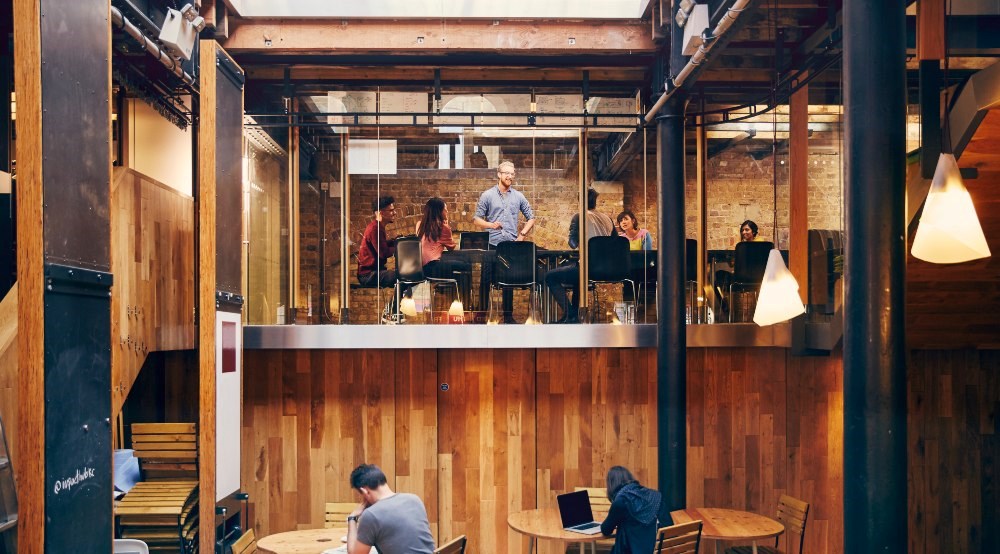
Want to talk it through?
Our experts know London’s office market inside and out, and our service is entirely free. So whether you need co-working, flexible or private office space, our team are here to help.

When you’re on the lookout for your next flexible office space, there are some minimum office workspace requirements that you absolutely must have — like space and lighting. But you also need to think about the ‘nice-to-have’ aspects, which set your office apart from all the other spaces.
Here, we’ll help you define the requirements for your new office so you can choose the aspects most important to you and your employees.
For any workspace, there are some minimal requirements that employers must consider. These include basic health and safety regulations outlined by the Workplace (Health, Safety and Welfare) Regulations 1992, which sets out the legal obligations employers must comply with when it comes to office space. These regulations cover everything from making sure your employees have sufficient floor area to cleanliness, lighting and ventilation.
When searching for a flexible workspace that’s a good fit for the needs of your team, it’s important to think about how you’ll meet your obligations within that space. Here are the key office space requirements that you need to be aware of in the UK:
The Workplace Regulations state: “The total volume of the room, when empty, divided by the number of people normally working in it should be at least 11 cubic metres.” In practical terms, this means you should assign at least 55 sq ft of space per person.
But this can quickly get costly, especially if you’re a startup with constantly changing team sizes. Rather than paying for more office space to meet the legal obligations, you could take steps to reduce your requirements. Hybrid working, for example, can reduce the number of workstations you need, while cloud computing services and external storage units free up more floor space. Or, you may choose to look for as large an office as you can afford in favour of creating more social spaces for your team to recharge during the working day.

All office spaces must conduct the appropriate risk assessment and tests where needed, such as ensuring fire alarms and any electric equipment are in full working condition. While there’s no specific law that states you must carry out electric testing in commercial properties, the Electricity at Work Regulations (1989) state that all equipment must be safe for use. Electrical testing it is, then.
Typically, your office space owner will organise this testing for you, but it’s a good idea to know when this will happen so your team can bring any work-from-home equipment into the office to ensure it passes inspection.
It almost goes without saying that your office needs to be comfortable to work in. This means it should be well lit, and there are several office lighting ideas that can help you illuminate your workspace. However, the lighting decision lies with the flexible office space provider, so it’s a good idea to visit the office space to see which available options work best for you. We suggest looking for offices flooded with natural light, or spaces that give you the freedom to add lighting options, such as table lamps, where necessary.
You should also take the office temperature into consideration. If, for example, your office space faces the sun for most of the day, your space can very quickly heat up, so the space should have good air conditioning facilities. The optimal temperature for offices sits between 21℃ - 23℃. Temperatures outside of this range can start to affect productivity.
Since the pandemic, there’s been a clear increase in the number of employees working from home with some regularity. And with 54% of workers preferring to work from home at least three days a week, according to a study published by King’s College London, business owners have had to adapt to a more flexible hybrid working policy in order to keep their teams happy.
But, with senior management teams wanting staff to come into the workplace more and more, the benefits need to shine through. Perhaps the easiest way to entice the team back in is with the office itself. After all, no one wants to commute for about an hour on average, if they’re not getting anything fulfilling out of it. Here are just some aspects to consider when it comes to choosing your office space.
Your health and wellbeing policies will affect your company culture and values. If your employees are generally happy, feel listened to and are open about their needs, then you’ve got a positive workforce. It can be easy to fall into bad company culture, so it’s important you continue listening to your team leads and adjusting policies in line with any changes or questions that may get asked.
Having a good company culture can, in turn, boost employee retention and recruitment. If potential employees know you value wellness, they’ll be more likely to apply for open roles, while existing employees will appreciate feeling well looked after and be more willing to stay at the company. Look at your benefits package and consider making adjustments in order to simultaneously attract top talent and keep the team you have. The best packages typically include a combination of financial, physical and mental offerings, such as competitive salaries, health insurance and subsidised gym memberships or cycle-to-work schemes.
There’s more of a focus on health and wellbeing, especially since the rate of self-reported stress, depression or anxiety related to work has shown signs of increasing in comparison to pre-pandemic levels. All these symptoms affect productivity levels and, more importantly, can increase the chances of your employees burning out, taking extended leave or, in extreme cases, quitting.
Now, there’s an onus on employers to look after their teams and ensure they’re happy, healthy and productive — both in work and outside of work.
Build wellness into employees’ daily work life by ensuring the office has breakout spaces that allow for deep thinking and ‘breathing room’. Look for biophilic elements in office spaces or simply look for flexible offices close to green spaces or those with rooftop terrace access, giving your team the chance to easily get outside and take a break.
Perhaps the most important factor to consider is your office location. As previously mentioned, the average worker loses an hour per day on the commute, which is already long enough. Look for an office close to plenty of transport links, ensuring it’s as accessible as possible. If your employees — and clients — can see the office is a little less than a five-minute walk from the closest Underground station, they’ll likely be more willing to make the tube journey in.
You should also think about the location outside of working hours. What are the food and drink options like? Will it be easy to organise a team social event in the local area? These kinds of amenities encourage employees to come into the office more regularly, especially if they know they’ll have easy access to incredible lunchtime street food options and the occasional post-work drink on a Friday.
However, it’s important to consider that with a prime location comes a prime price tag. Make sure you understand your budget as well as your business needs in order to find the space that suits you. Flexible office spaces are designed to rightsize along with your business, with shorter leases that can be easily adapted to include the space you need, so you’re not left paying for space that you’re not using.

As we discussed earlier, the office space is a key requirement for you to consider. But, where the office was traditionally more functional, employees are coming to expect a more engaging experience on a typical work day. The requirements of a pre-pandemic world just aren’t going to cut it anymore. After spending so long working remotely from home, it can be difficult to return to the rigid office layouts of a few years ago. Now, the trends are pointing to more homely and inviting layouts, with spaces reminiscent of member's clubs.
Communal areas where colleagues can sit and chat, take their minds off work for a few minutes, or even enjoy lunch or coffee together go a long way in creating a positive company culture. Or, create an agile working environment with hubs and zones for different tasks and requirements. Rather than looking at minimum requirements for your employees and equipment, think about what you want your office space to say about your company, and look for a flexible office space that mirrors your company values and culture, and shows clients and partners exactly who you are.
As an employer, you must make sure your workplace meets the minimum office workspace requirements. But wouldn’t it be great if you could do more than that? At Knight Frank, we know London’s office market inside out and can help you find the office space that ticks all of your boxes and provides a little bit more.
Get your monthly dose of workplace insights, productivity hacks and business leadership ideas - delivered straight to your inbox.

Our experts know London’s office market inside and out, and our service is entirely free. So whether you need co-working, flexible or private office space, our team are here to help.